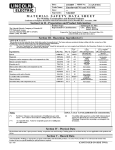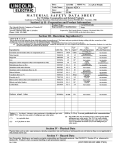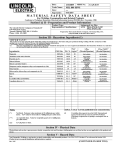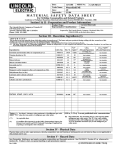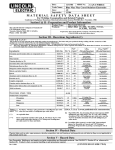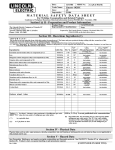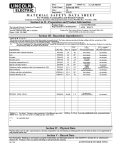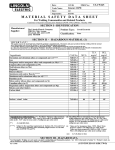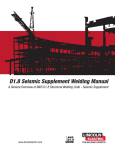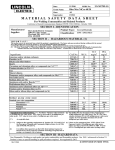Download Lincoln Electric CAN-F15 User's Manual
Transcript
Date: Trade Name: Sizes: Supersedes: MSDS No.: CAN-F15 1/5/2009 Lincolnweld 780 --5/1/2007 MATERIAL SAFETY DATA SHEET For Welding Consumables and Related Products Conforms to Workplace Hazardous Materials Information System (WHMIS) Rev. November, 1988 Section I & II - Preparation and Product Information Product Type: Representative Classifications: The Lincoln Electric Company of Canada LP 179 Wicksteed Avenue Toronto, Ontario M4G 2B9 CANADA Phone: (416) 421-2600 Submerged Arc Flux CSA F49A2-EL12 F49A3-EM12K Prepared by The Lincoln Electric Company, Cleveland, Ohio, USA (216) 481-8100, on the date shown above. Section III - Hazardous Ingredients (1) IMPORTANT! This section covers the materials from which this product is manufactured. The fumes and gases produced during welding with the normal use of this product are covered by Section VII; see it for industrial hygiene information. CAS Number shown is representative for the ingredients listed. (1) The term “hazardous” in “Hazardous Ingredients” should be interpreted as a term required and defined in the Hazardous Products Act and does not necessarily imply the existence of any hazard. TLV mg/m Ingredients: CAS No. Wt. % 3 LD50 (Route/Species) LC50 mg/m3 (Route/Species) Not Available (oral/rat) Not Available 2.3 LCLo (inhalation/human) Aluminum oxide and/or Bauxite 1344-28-1 30-60 10 Manganese and/or manganese alloys and compounds (as Mn) 7439-96-5 10 0.2 Titanium dioxides 13463-67-7 5-10 10 Silicates and other binders 1344-09-8 5-10 10* 1153 mg/kg (oral/rat) Not Available Fluorides (as F) 7789-75-5 5-10 2.5 4250 mg/kg (oral/rat) Not Available Silicon and/or silicon alloys and compounds (as Si) 7440-21-3 1-5 10* Not Available Not Available Iron 7439-89-6 1-5 10* Not Available Not Available Magnesite 1309-48-4 1-5 10 Not Available 590 g/kg LDLo (oral/rat) reproductive 200 mg/kg LDLo (intratracheal/rat) Not Available Mineral silicates 1332-58-7 1-5 5** Quartz 14808-60-7 0.1-1 #0.05** #0.025* * 5 Crystalline-Silica (cristobalite) 14464-46-1 0.1-1 Zirconium alloys and compounds (as Zr) 12004-83-0 0.1-1 9 g/kg Not Available 10,000 mg/kg Not Available Not Available (oral/rat) Not Available 300 LCLo (inhalation/human) Not Available Not Available (LDLo, LCLo) Lowest published toxic concentration. Notes: (*) Not listed. Nuisance value maximum is 10 milligrams per cubic meter. TLV value for iron oxide is 5 milligrams per cubic meter. (**) As respirable dust. Value for respirable quartz is 0.1 milligrams per cubic meter. (#) Crystalline silica (quartz) is on the IARC (International Agency for Research on Cancer) and NTP (National Toxicology Program) lists as posing a carcinogenic risk to humans. Section IV - Physical Data Physical data such as odor, vapor pressure, density, evaporation rate and freezing or boiling points are not listed as they are not applicable to this product and its use. Section V - Hazard Data Non Flammable; Welding arc and sparks can ignite combustibles and flammable products. See CSA W117.2 Section 9.7 as referenced in Section VIII. Product is inert, no special handling or spill procedures required. Rev 9/07 (CONTINUED ON SIDE TWO) Product: Lincolnweld 780 Date: 1/15/2009 Section VI - Health Hazard Data and Toxicological Properties Acute Lethality Values: LC50 means the concentration of a substance in air that when administered by means of inhalation over a specified length of time in an animal assay, is expected to cause the death of 50% of a defined animal population. LD50 means the single dose of a substance that, when administered by a defined route in an animal assay, is expected to cause the death of 50% of a defined animal population. Threshold Limit Value: The ACGIH recommended general limit for Welding Fume NOS - (Not Otherwise Specified) is 5 mg/m3. The TLV-TWA is the time-weighted average concentration for a normal 8-hour workday and a 40 hour workweek, to which nearly all workers may be repeatedly exposed, day after day, without adverse effect. See Section VII for specific fume constituents which may modify this TLV. Threshold Limit Values are figures published by the American Conference of Government Industrial Hygienists. Effects of Overexposure: Electric arc welding may create one or more of the following health hazards: Fumes and Gases can be dangerous to your health. Common entry is by inhalation. Other possible routes are skin contact and ingestion. Short-term (acute) overexposure to welding fumes may result in discomfort such as metal fume fever, dizziness, nausea, or dryness or irritation of nose, throat, or eyes. May aggravate pre-existing respiratory problems (e.g. asthma, emphysema). Exposure to extremely high levels of fluorides can cause abdominal pain, diarrhea, muscular weakness, and convulsions. In extreme cases it can cause loss of consciousness and death. Long-term (chronic) overexposure to welding fumes can lead to siderosis (iron deposits in lung) and may affect pulmonary function. Manganese overexposure can affect the central nervous system, resulting in impaired speech and movement. Bronchitis and some lung fibrosis have been reported. Repeated exposure to fluorides may cause excessive calcification of the bone and calcification of ligaments of the ribs, pelvis and spinal column. May cause skin rash. Overexposure to crystalline silica present in dust from this material can cause severe lung damage (silicosis). Respiratory overexposure to airborne crystalline silica is known to cause silicosis, a form of disabling pulmonary fibrosis which can be progressive and may lead to death. Crystalline silica is on the IARC (International Agency for Research on Cancer) and NTP (National Toxicology Program) lists as posing a cancer risk to humans. Arc Rays can injure eyes and burn skin. Skin cancer has been reported. Electric Shock can kill. If welding must be performed in damp locations or with wet clothing, on metal structures or when in cramped positions such as sitting, kneeling or lying, or if there is a high risk of unavoidable or accidental contact with workpiece, use the following equipment: Semiautomatic DC Welder, DC Manual (Stick) Welder, or AC Welder with Reduced Voltage Control. Section VII - Reactivity Data Hazardous Decomposition Products: Welding fumes and gases cannot be classified simply. The composition and quantity of both are dependent upon the metal being welded, the process, procedure and electrodes used. Other conditions which also influence the composition and quantity of the fumes and gases to which workers may be exposed include: coatings on the metal being welded (such as paint, plating, or galvanizing), the number of welders and the volume of the worker area, the quality and amount of ventilation, the position of the welder's head with respect to the fume plume, as well as the presence of contaminants in the atmosphere (such as chlorinated hydrocarbon vapors from cleaning and degreasing activities.) When the electrode is consumed, the fume and gas decomposition products generated are different in percent and form from the ingredients listed in Section III. Decomposition products of normal operation include those originating from the volatilization, reaction, or oxidation of the materials shown in Section III, plus those from the base metal and coating, etc., as noted above. Reasonably expected fume constituents of this product would include: Primarily iron oxide and fluorides; secondarily complex oxides of aluminum, calcium, magnesium, manganese, potassium, silicon and sodium with recommended Lincolnweld electrodes. (See MSDS for electrode being used.) Maximum fume exposure guideline for this product (based on manganese content) is 4.0 milligrams per cubic meter. Maximum respirable dust exposure guideline and PEL for this flux (based on crystalline silica) is 2.0 milligrams per cubic meter. Handle to minimize generation of airborne dust. Use adequate ventilation and dust collection. Use respiratory protection, if required, to keep exposure below limits. TLV value for respirable quartz is 0.05 milligrams per cubic meter. Gaseous reaction products may include carbon monoxide and carbon dioxide. Ozone and nitrogen oxides may be formed by the radiation from the arc. Determine the composition and quantity of fumes and gases to which workers are exposed by taking an air sample from inside the welder's helmet if worn or in the worker's breathing zone. Improve ventilation if exposures are not below limits. See ANSI/AWS F1.1, F1.2, F1.3 and F1.5, available from the American Welding Society, 550 N.W. LeJeune Road, Miami, FL 33126. Section VIII - Preventive Measures and Precautions for Safe Handling and Use Read and understand the manufacturer's instruction and the precautionary label on the product. Request Lincoln Safety Publication E205. See Canadian Standards Association Standard CSA-W117.2 "Safety in Welding, Cutting, and Allied Processes" published by the Canadian Standards Association, 178 Rexdale Blvd., Rexdale, Ontario M9W1R3 for more details on many of the following: Ventilation: Use enough ventilation, local exhaust at the arc, or both to keep the fumes and gases from the worker's breathing zone and the general area. Train the welder to keep his head out of the fumes. Keep exposure as low as possible. Use adequate dust control measures. Respiratory Protection: Use respirable fume respirator or air supplied respirator when welding in confined space or general work area when local exhaust or ventilation does not keep exposure below TLV. Eye Protection: Wear helmet or use face shield with filter lens shade number * or darker. Shield others by providing screens and flash goggles. (*) No specific recommendation for submerged arc. Protective Clothing: Wear hand, head, and body protection which help to prevent injury from radiation, sparks and electrical shock. See W117.2. At a minimum this includes welder's gloves and a protective face shield, and may include arm protectors, aprons, hats, shoulder protection, as well as dark substantial clothing. Train the welder not to permit electrically live parts or electrodes to contact skin . . . or clothing or gloves if they are wet. Insulate from work and ground. Disposal Information: Discard any product, residue, disposable container, or liner as ordinary waste in an environmentally acceptable manner according to Federal, State and Local regulations unless otherwise noted. No applicable ecological information available. Section IX - Emergency and First Aid Procedures Call for medical aid. Employ first aid techniques recommended by the Canadian Red Cross. IF BREATHING IS DIFFICULT give oxygen. IF NOT BREATHING employ CPR (Cardiopulmonary Resuscitation) techniques. IN CASE OF ELECTRICAL SHOCK, turn off power and follow recommended treatment. In all cases call a physician.


